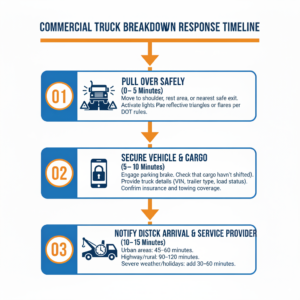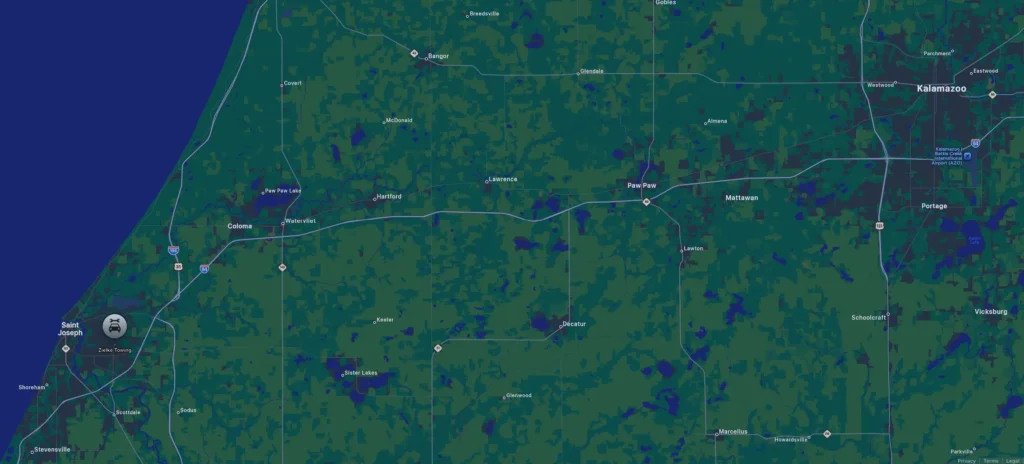When a commercial truck breakdown happens on the road, time isn’t just money – it’s also safety, deadlines, and business reputation on the line. One of the first questions truck drivers, fleet managers, and even customers ask is: “How long will it take to tow this truck?”
The reality is that commercial truck towing isn’t as straightforward as a quick roadside pickup. Unlike passenger vehicles, semi-trucks, box trucks, and heavy-duty rigs require specialized equipment, trained operators, and compliance with Department of Transportation (DOT) standards.
This guide will break down how long towing usually takes, the factors that affect towing times, and the steps drivers can take to minimize delays. Think of it as your roadside action plan – clear, authoritative, and practical.
Every Driver’s Time-Sensitive Question
Picture this: you’re hauling cargo along I-94 near Benton Harbor, MI, when suddenly your rig shudders, a warning light flashes, and power fades. You know it’s a breakdown. You contact dispatch, and the first thing you want to know is: “How fast can the tow truck get here?”
Here’s the honest answer: towing a commercial vehicle typically takes 45 minutes to 2 hours for arrival, plus additional time for hook-up and transport. But the exact timeline depends on critical factors like location, time of day, truck type, and service availability.
Fleet managers in Benton Harbor (1303 M-139, Benton Harbor, MI 49022, United States) report that response times can double during peak traffic hours, severe weather, or holidays.
This is why understanding the full breakdown-to-resolution process is essential. Let’s start with the first part of the journey: immediate safety actions and time-to-arrival.
Immediate Safety and Response Timeline

When your truck breaks down, here’s a step-by-step timeline of what typically happens before the tow truck even arrives:
Step 1 → Pull Over Safely (0–5 Minutes)
- Move to the shoulder, rest area, or nearest safe exit.
- Activate hazard lights immediately.
- Place reflective triangles or flares per DOT rules.
Step 2 → Secure Vehicle and Cargo (5–10 Minutes)
- Engage the parking brake.
- Check that cargo hasn’t shifted.
- Stay inside the cab unless it’s unsafe.
Step 3 → Notify Dispatch & Service Provider (10–15 Minutes)
- Report your location (mile marker, GPS, or landmark).
- Provide truck details (VIN, trailer type, load status).
- Confirm insurance and towing coverage.
Step 4 → Estimated Tow Truck Arrival (45–120 Minutes)
- Urban areas: often 45–60 minutes.
- Highway/rural areas: 90–120 minutes.
- Severe weather/holidays: add 30–60 minutes.
Industry best practice: Fleet managers recommend drivers ask for a realistic ETA and request updates every 20–30 minutes until the tow truck arrives.
Hook-Up & Tow Preparation Timeline
Once the tow truck arrives, the clock resets. Many drivers assume the truck is hooked and ready to roll in minutes – but commercial rigs are a different story. Heavy-duty towing is a technical process, requiring specialized equipment and careful safety steps.
Step 1 → Site Assessment (5–15 Minutes)
The operator must first assess the scene:
- Road conditions (traffic, weather, shoulder space).
- Truck position (straight, jackknifed, or off-road).
- Cargo stability and trailer angle.
Experienced drivers recommend giving the tow operator space and staying clear during assessment. A misstep here can delay the hook-up significantly.
Step 2 → Equipment Setup (10–20 Minutes)
Unlike light-duty tows, commercial trucks require heavy-duty wreckers with booms, winches, and stabilizers.
- Wheel lifts or under-reach mechanisms must be positioned correctly.
- Safety chains and rigging must be double-checked.
- In poor weather, add 5–10 minutes for stabilization.
At 1303 M-139, Benton Harbor, MI 49022, local roadside assistance providers note that setup time often doubles on icy highways where trucks must be winched from embankments.
Step 3 → Hook-Up & Securing the Vehicle (20–40 Minutes)
This is the most time-consuming stage:
- Attaching the wrecker to the drive axle or tow bar.
- Disconnecting the driveshaft to prevent transmission damage.
- Checking air lines, brakes, and electrical systems before movement.
- Ensuring trailer stability (especially with hazmat or refrigerated cargo).
👉 If your load is oversized or requires DOT oversize/overweight permits, add another 30–60 minutes while paperwork and routing are handled.
Step 4 → Final Safety Check (5–10 Minutes)
Before departure, the operator performs a walk-around inspection:
- Cargo straps secured.
- Safety lights engaged.
- Clearance and height verified for bridges and overpasses.
Only once all checks are complete does the tow truck begin its journey to the repair facility.
⚡ Key takeaway: Even after the tow truck arrives, expect at least 1 hour before rolling again. For complex breakdowns, double that time.
Transport & Delivery Timeline
Once the truck is hooked and secured, the journey isn’t over – it’s just beginning. The transport stage determines how long your truck, trailer, and cargo will be out of commission. Depending on distance, road conditions, and destination type, this leg can range from 30 minutes to several hours.
Step 1 → Departure from Breakdown Site (5–10 Minutes)
- The tow operator eases the truck into traffic.
- Hazard lights and escort vehicles may be required for oversized loads.
- In high-traffic corridors (like I-94 near Benton Harbor, MI), merging into traffic safely may take extra time.
Step 2 → Travel to Repair Facility (30–180 Minutes)
The bulk of towing time is the actual trip:
- Short hauls (local shop): 30–45 minutes.
- Regional tows (50–100 miles): 1–2 hours.
- Long-distance recovery: 3–5+ hours, sometimes requiring relay to another provider.
Fleet managers report: Average recovery in Michigan is under 90 minutes when towing to local truck repair services or roadside hubs near 1303 M-139, Benton Harbor, MI 49022, United States.
Step 3 → Arrival & Positioning at Destination (10–20 Minutes)
- Maneuvering into the shop bay or drop yard can take longer than expected, especially in tight urban facilities.
- For 24/7 repair shops, tow trucks often unload quickly, but during off-hours, drivers may have to wait for gated access.
Example Timeline: Benton Harbor Breakdown → Repair Shop
- Breakdown reported on I-94 near mile marker 28.
- Tow truck arrival in 60 minutes.
- Hook-up completed in 50 minutes.
- Travel to shop at 1303 M-139, Benton Harbor, MI → 40 minutes.
Total downtime: ~2.5–3 hours.
⚡ Key takeaway: Travel time depends heavily on distance to the nearest heavy-duty repair provider. Rural drivers should always factor in longer delays.
Regulatory & Business Impact Timeline
A commercial truck breakdown isn’t just about mechanical recovery – it directly impacts DOT compliance, customer deadlines, and fleet operations. Even if the tow itself only takes a few hours, the business and regulatory fallout can stretch much longer.
Step 1 → DOT Hours of Service (Immediate to 24 Hours)
The Federal Motor Carrier Safety Administration (FMCSA) requires strict logging of driver hours.
- If breakdown + towing consumes 2–5 hours, that still counts toward on-duty time.
- Drivers may hit their 14-hour duty window and require mandatory rest before resuming.
- ELD (Electronic Logging Device) entries must document breakdowns accurately.
⚠️ Industry best practice: Fleet managers recommend logging “truck breakdown procedures” in detail to avoid Hours of Service violations.
Step 2 → Cargo & Delivery Commitments (Same Day to Several Days)
Towing delays ripple into supply chain obligations:
- Perishable goods may require transloading into another truck within hours.
- Just-in-time freight (auto parts, manufacturing) could trigger penalties if late.
- Customer contracts often mandate notification within 30–60 minutes of incident.
👉 Is your cargo secure and properly documented? Photos and dispatch updates protect you from claims.
Step 3 → Insurance & Liability Processing (1–7 Days)
- Insurance requires photos, tow invoices, and incident reports.
- Liability shifts depending on whether the breakdown caused secondary damage (e.g., spilled cargo, roadway obstruction).
- For hazmat spills, environmental compliance can add days to resolution.
Local fleets around 1303 M-139, Benton Harbor, MI 49022, United States report that insurers often delay claims if drivers fail to submit mile markers and tow documentation immediately.
Step 4 → Fleet-Wide Operational Adjustments (1–24 Hours)
- Dispatch may reroute other trucks to cover missed loads.
- Backup drivers may be deployed for priority freight.
- Large fleets rely on breakdown management software to adjust schedules in real-time.
⚡ Key takeaway: Even if towing only takes 2–3 hours, the business disruption can last a full day or more.
Part 5: Prevention & Efficiency Strategies
If waiting 2–3 hours for a tow truck feels costly, you’re right. Every minute of downtime means lost revenue, delivery delays, and extra stress. The best way to shorten towing timelines is to prevent breakdowns in the first place – and to prepare for them when they do happen.
Step 1 → Master Pre-Trip Inspections
A disciplined pre-trip inspection is the frontline defense against roadside breakdowns.
- Check fluids, belts, and hoses before departure.
- Inspect tires for pressure and tread depth.
- Test brakes, lights, and emergency equipment.
Experienced drivers recommend using a 15-minute daily checklist – small issues caught early can prevent hours of waiting for a tow.
Step 2 → Route Planning with Service Providers in Mind
Not all breakdowns happen near Benton Harbor or other urban hubs. Long stretches of rural interstates can mean longer wait times.
- Identify heavy-duty service providers along your route.
- Note safe stopping areas for emergencies.
- Keep a list of preferred towing partners in each region.
👉 Smart fleets pre-load provider contacts into dispatch systems for instant response.
Step 3 → Stock an Emergency Kit
Every driver should carry:
- Basic tools and spare fuses.
- Reflective triangles and high-visibility gear.
- Communication backup (CB radio or satellite phone).
- First aid supplies.
This doesn’t replace a tow – but it keeps drivers safe and visible while waiting.
Step 4 → Use Technology to Reduce Downtime
Modern fleet management tools are designed for breakdown scenarios:
- GPS-enabled mobile apps share breakdown locations instantly.
- ELD-integrated systems flag downtime automatically.
- Real-time dispatch platforms let fleets coordinate recovery faster.
Fleet managers report that trucks equipped with GPS breakdown reporting cut towing arrival times by 20–30%.
Step 5 → Build Strong Towing Partnerships
Waiting 2+ hours for a random tow truck is risky. Instead:
- Establish contracts with 24/7 heavy-duty towing providers.
- Confirm they can handle semi-truck repair, roadside assistance, and recovery.
- Verify insurance coverage and regulatory compliance.
Local fleets near 1303 M-139, Benton Harbor, MI 49022, United States often partner with the same provider for consistent response times under 60 minutes.
Final Word
A commercial truck breakdown doesn’t have to derail your schedule. While towing can take anywhere from 2 to 6+ hours (arrival, hook-up, transport, and delivery), the business impact can last longer if you’re unprepared.
By combining proactive maintenance, smart planning, and reliable towing partnerships, drivers and fleets can keep downtime under control – and keep freight moving.





